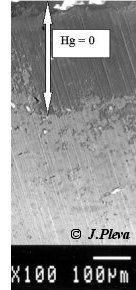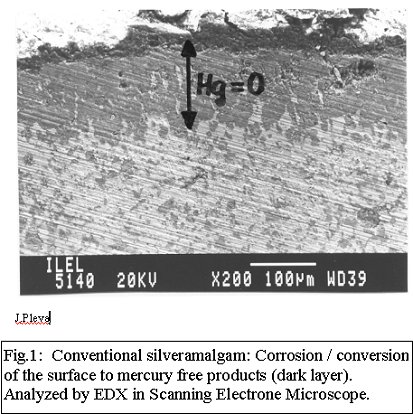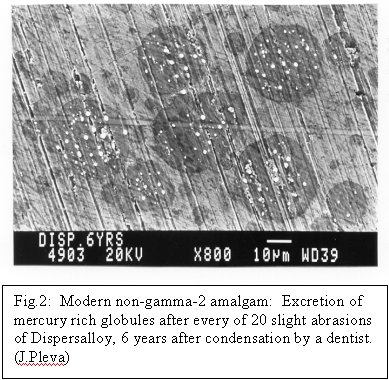See the microscopic evidence of mercury release from amalgams.

In the following letter, it's revealed how dental amalgam corrodes and releases most of its mercury in just a few years.

The amount of mercury and where it disapeares to is still to be shown in a satisfactory way. But considering the fact that the mercury from a thermometer "conteminates" a whole room for years, the amount of mercury in the mouths of many dental amalgam bearers should pose a serious hazard to their health.
----- ---- ---- ---- ---- ---- -----
Från: Jaro Pleva
Till: richard.butcher@mail.house.gov
Skickat: den 21 november 2002 10:10
Ämne: Hearing on Mercury in Dental Amalgam
From Jaro Pleva, PhD, corrosion chemistry, retired section manager/metallurgist
Lakheden 20
SE-68392 HAGFORS
SWEDEN
For submission to the Congressional Record, November 14, 2002, Hearing on Mercury in Dental Amalgam: An Examination of the Science.
To: Chairman Dan Burton, Rep. Diane Watson, and Members of the Committee on Government Reform.
Dear Sir,
it is well known that dental amalgams (DA) corrode and are subject to wear. The desperate efforts of the compromized dental representants to deny the tendency to deterioration and consecutive mercury release have been many. In Sweden, perhaps the most active pro-amalgam advocates have been Maud Bergman, University of Umeå, and Per-Olof Glantz, University of Malmö. In 1982, these professors have been commisioned by the Swedish Social Welfare Board to conduct a review of the risks of dental amalgam fillings deteriorating, releasing mercury, and causing the danger to health.
They reported (literal translation): "In our opinion, the available scientific literature does not contain any scientifically confirmed results, which would indicate a clinical systematic deterioration of silver amalgam fillings."

This formal report, among others, was clearly untruth and fraud in both science and clinical medicine, threatening the health of millions of people. You find enough references in the literature list in my publications, attached to this mail.

I mention this just to show, that the DA-issue is not only a scientific one, not only about bringing a clear-cut evidence of the danger of implanted heavy metals.
The material aspects in the Dental Amalgam Issue can be used for evaluation of the mercury exposure in dental patients. This possibility of the mercury exposure-estimate has been neglected in the debate of the exposure and of the danger of the released mercury. Logically, mercury found in blood, urine or body tissues is so far from its source, that it will not mirror the amounts the body has been exposed to, even more so if the excreeting function of kidneys had been impaired by the same mercury.
Nowadays, there are two main brands of DA on the market:
a) Conventional silveramalgam
b) Modern non-gamma-2 amalgams.
Both of them deteriorate and corrode, but the noticeable features are somewhat different. I attache two figures with representative appearance of both brands, indicating release of mercury:

a) The conventional silveramalgam in Fig. 1 shows corrosion after several years of exposure in vivo. On the polished section through the filling, a dark surface layer has been converted (corroded) to corrosion products, free of mercury. Often, there is no lack of the bulk material, visible to bare eye, but in the Scanning Electrone Microscope (SEM) both the morphology and decreased mercury content can be documented. Not difficult at all, but still kept as secret as possible by the dental profession.
b) The non-gamma-2 amalgams (with increased copper contents) after slight abrasion are shown in Fig.2. Here, the special feature is excretion of tiny mercury rich globules (white dots). The excretion occurs irrespective the age of the specimen. It is not an attribute of the vacuum in the SEM, as exactly same phenomenon has been observed in optical microscope at ambient conditions. More than 20 abrasions have been made with the same results.
Counting the globules per surface unit renders it possible to calculate the released mercury, and thus exposure. It makes about 20 micrograms per abrasion from 1 cm2, which gives ca 200 micrograms after one chewing event, in an average patient with 10 cm2 of amalgam surface.

This is 8 times the occupational limit of 25 micrograms Hg a day.
I wish to add, that I have been chronically poisoned by DA-mercury and got my health back only after removal of the DA-fillings. My case is described in the reference nr. 1 in the attached list of publications. 19 years later I feel more healthy than ever and must only confirm my previous conclusion, that the amalgam therapy markedly disturbed my health and the quality of my life during many years. Moreover, it had been the most serious health problem in my life.
Sincerely yours
Jaro Pleva, PhD

Attachments:
Fig. 1
Fig. 2
List of Publications. (Sent with another mail today.) The review (6) is recommended as overall review of the issue without bias.
 Amalgam is releasing mercury
Amalgam is releasing mercury

